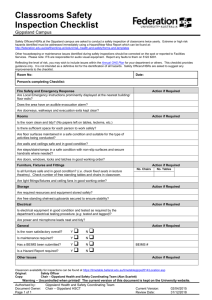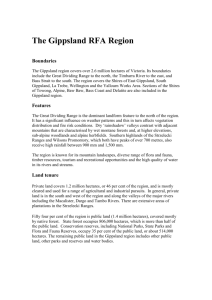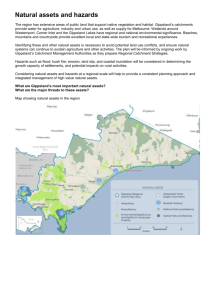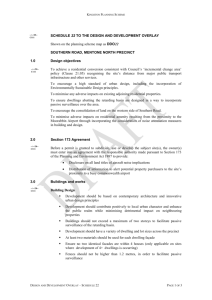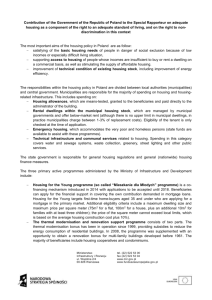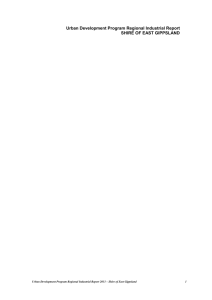MINISTERIAL DIRECTION - East Gippsland Shire Council
advertisement
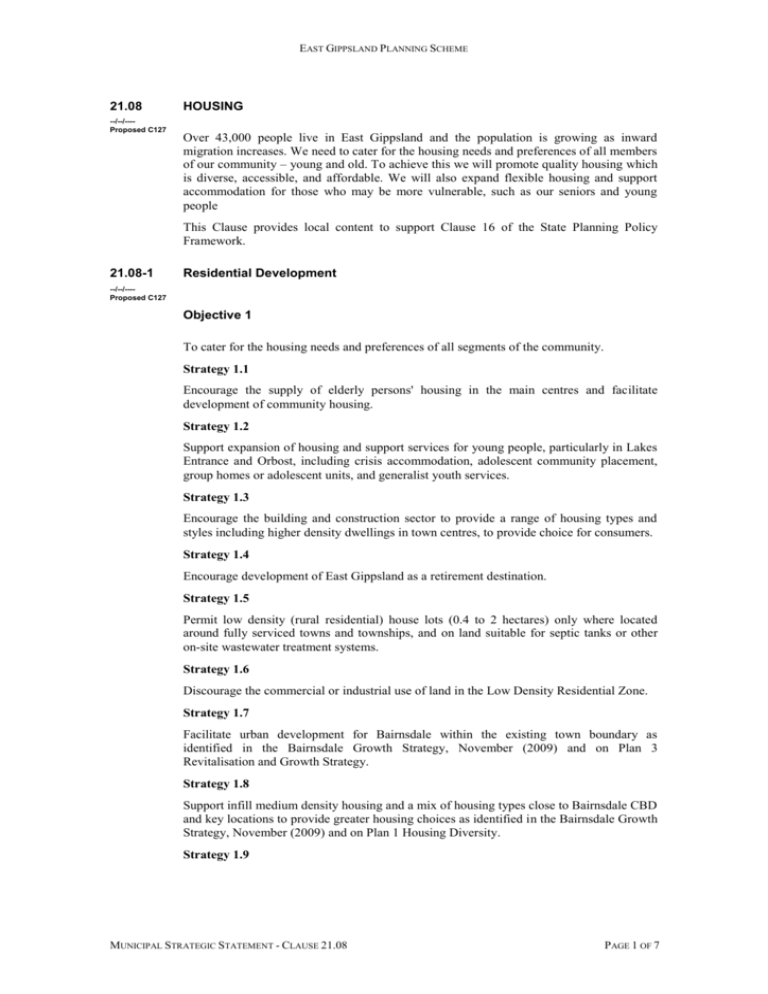
EAST GIPPSLAND PLANNING SCHEME 21.08 --/--/---Proposed C127 HOUSING Over 43,000 people live in East Gippsland and the population is growing as inward migration increases. We need to cater for the housing needs and preferences of all members of our community – young and old. To achieve this we will promote quality housing which is diverse, accessible, and affordable. We will also expand flexible housing and support accommodation for those who may be more vulnerable, such as our seniors and young people This Clause provides local content to support Clause 16 of the State Planning Policy Framework. 21.08-1 Residential Development --/--/---Proposed C127 Objective 1 To cater for the housing needs and preferences of all segments of the community. Strategy 1.1 Encourage the supply of elderly persons' housing in the main centres and facilitate development of community housing. Strategy 1.2 Support expansion of housing and support services for young people, particularly in Lakes Entrance and Orbost, including crisis accommodation, adolescent community placement, group homes or adolescent units, and generalist youth services. Strategy 1.3 Encourage the building and construction sector to provide a range of housing types and styles including higher density dwellings in town centres, to provide choice for consumers. Strategy 1.4 Encourage development of East Gippsland as a retirement destination. Strategy 1.5 Permit low density (rural residential) house lots (0.4 to 2 hectares) only where located around fully serviced towns and townships, and on land suitable for septic tanks or other on-site wastewater treatment systems. Strategy 1.6 Discourage the commercial or industrial use of land in the Low Density Residential Zone. Strategy 1.7 Facilitate urban development for Bairnsdale within the existing town boundary as identified in the Bairnsdale Growth Strategy, November (2009) and on Plan 3 Revitalisation and Growth Strategy. Strategy 1.8 Support infill medium density housing and a mix of housing types close to Bairnsdale CBD and key locations to provide greater housing choices as identified in the Bairnsdale Growth Strategy, November (2009) and on Plan 1 Housing Diversity. Strategy 1.9 MUNICIPAL STRATEGIC STATEMENT - CLAUSE 21.08 PAGE 1 OF 7 EAST GIPPSLAND PLANNING SCHEME Support residential development within East Bairnsdale which minimises off site amenity impacts, and protects the ongoing rights of local industry and employment including Patties Foods and includes appropriate land use buffers. Objective 2 To ensure social considerations are taken into account when considering applications for residential development. Strategy 2.1 Require applications for residential subdivision to include a social impact comment (SIC) or social impact assessment (SIA) in accordance with the East Gippsland Shire Council Social Impact Assessment Guidelines for Development Applications (for details refer to Policy Guidelines – Residential Development listed below. Objective 3 To encourage residential development to be directed to locations that minimises negative impacts on the Shire’s urban waterways. Strategy 3.1 Manage the impacts of new residential developments on waterways through the application of the principles of the East Gippsland Shire Council Urban Waterway Guidelines. MUNICIPAL STRATEGIC STATEMENT - CLAUSE 21.08 PAGE 2 OF 7 EAST GIPPSLAND PLANNING SCHEME Plan 1 Housing Diversity MUNICIPAL STRATEGIC STATEMENT - CLAUSE 21.08 PAGE 3 OF 7 EAST GIPPSLAND PLANNING SCHEME 21.08-2 Rural Living Development --/--/---Proposed C127 Objective 1 To encourage developments which increase the quality, diversity of types and tenures, and the affordability of housing. Strategy 1.1 Ensure that areas proposed for future rural living: are in accessible locations; will not have an adverse effect on agricultural productivity; are located on land physically and environmentally capable of sustaining development; and can be serviced effectively and economically. Strategy 1.2 Permit rural living development (lots 2-8 hectares), in areas having the capacity for provision of full urban services or identified future growth corridors, as an interim measure with designs to facilitate re-subdivision in future. Strategy 1.3 Discourage subdivision for rural living in agricultural areas. Strategy 1.4 Provide for primarily residential uses in a non-urban environment on land zoned Low Density Residential (lot sizes from 4000 square metres to 2 hectares) or Rural Living (from 2 to 8 hectares). Strategy 1.5 Discourage the commercial or industrial use of land in the Rural Living Zone. Strategy 1.6 Control the release of small-lot rural land and rezone at a rate which ensures that land released does not compete with fully serviced lots in urban centres. Strategy 1.7 Limit subdivision for small (hobby) farm lots (up to 40 hectares); only permitting it where land degradation, environmental, and management problems will not be created. Implementation The strategies in relation to housing will be implemented through the planning scheme by: Policy Guidelines Residential Development Applications for a subdivision which will create between 20 lots and 60 lots are to provide a social impact comment in accordance with the East Gippsland Shire Council Social Impact Assessment Guidelines for Development Applications. MUNICIPAL STRATEGIC STATEMENT - CLAUSE 21.08 PAGE 4 OF 7 EAST GIPPSLAND PLANNING SCHEME Applications for a subdivision which will create more than 60 lots are to provide a social impact assessment in accordance with the East Gippsland Shire Council Social Impact Assessment Guidelines for Development Applications. When considering applications for residential development consider the impacts of proposed works on urban waterways as identified in the East Gippsland Shire Council Urban Waterway Guidelines. When considering applications for new residential development, take into account recommendations as identified within the Bairnsdale Growth Strategy, November (2009). Other Actions Undertake in partnership with DHS, a full social and physical urban renewal program in East Bairnsdale to re-think the subdivision layout and assess opportunities for housing renewal and upgrades. Rural Dwellings Request rural dwelling proposals to provide the following information as appropriate: A Land Capability Assessment conducted in accordance with Section 4.5 of the Code of Practice Onsite Wastewater Management Environment Protection Authority Publication 891.2 (or as amended). Assess applications for rural dwellings against the following criteria: rural dwellings on land adjoining Crown land should be sited to allow buffer and protection zones as by the Country Fire Authority to minimise impacts on environmental and other values of public land; and an application for a second or subsequent dwelling on a single lot should demonstrate the dwelling is required for the purposes of activities to be carried out on the subject land. Such dwellings should be sited in a way that is capable of providing legal access to each dwelling and should generally not have access from zoned Road. When deciding on applications for rural dwellings consider, as appropriate: in making its decision on applications to construct dwellings not related to farming or other productive use of the relevant land, Council will consider the distance of the proposed dwelling from the community centre and whether the development is likely to place unreasonable demands on services. Small Lot Subdivisions Request small lot subdivision proposals to provide the following information as appropriate: A whole farm management plan for each relevant lot, showing: the proposed range of uses; any native vegetation on the lots which is proposed to be cleared as a consequence of the development; how the development and use of the land will address any constraints or special values identified; how the agricultural use of the land will be managed to minimise impacts on dwellings or potential dwellings on adjoining lots. Assess applications for small lot excisions against the following criteria: MUNICIPAL STRATEGIC STATEMENT - CLAUSE 21.08 PAGE 5 OF 7 EAST GIPPSLAND PLANNING SCHEME applications that excise existing dwellings should have a minimum of 2 hectares that contains the dwelling; dwellings excised must be in a habitable condition; and where applications to excise an existing dwelling would leave a balance area which is smaller than the minimum lot size for the zone, consolidation of the balance of the lot with an adjoining lot or lots should occur. When deciding on applications for lots smaller than the minimum consider, as appropriate: the availability of undeveloped lots of the proposed size range in the relevant area and any need for additional smaller lots as a consequence of new or innovative agricultural or pastoral development, or proposed tourism enterprises or rural service businesses; the ability of the land to be developed without adverse impacts on areas with special values or the likelihood of increasing the risks of degradation in areas with development constraints, including: land covered by a Bushfire Management Overlay; land covered by an Environmental Significance Overlay or otherwise having high environmental values; water catchments for urban / domestic supply or aquifer recharge areas (including those shown in Map 5 of the Municipal Strategic Statement); areas of high landscape quality or adjoining scenic roads (including those shown in Maps 2 and 3 of the Municipal Strategic Statement); areas covered by the Land Subject to Inundation Overlay, or otherwise subject to flood risk; and land covered by an Erosion Management Overlay or otherwise subject to high erosion risk. the appropriate separation between the lot(s) and: prime or high quality agricultural land; high bushfire risk; urban waterways high environmental significance; and foreshores, lakes and river frontages. Application of Zones and Overlays Applying the Low Density Residential Zone close to existing urban areas with access to all urban services and where environmental quality and sensitivities are not high. Applying the Farming Zone to protect agricultural areas from inappropriate development. Consider the application of a Design and Development Overlay on residential land in East Bairnsdale along the Princes Highway that has an interface with business. Reference Documents Low Density Living Study (October 1997) Onsite Wastewater Management Environment Protection Authority publication No 891.2 (or as amended) East Gippsland Shire Council Social Impact Assessment Guidelines for Development Applications (EGSC May 2013) MUNICIPAL STRATEGIC STATEMENT - CLAUSE 21.08 PAGE 6 OF 7 EAST GIPPSLAND PLANNING SCHEME East Gippsland Shire Council Urban Waterway Guidelines (EGSC March 2013) Bairnsdale Growth Strategy, November (2009) MUNICIPAL STRATEGIC STATEMENT - CLAUSE 21.08 PAGE 7 OF 7
